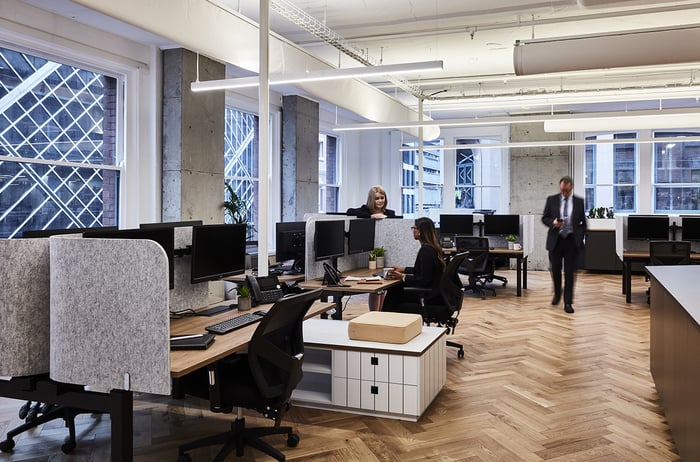Are open-plan offices really good for collaboration?
When it comes to open-plan offices, there are generally two schools of thoughts. As Ethan S. Bernstein, associate professor at Harvard Business School, puts it:
You hear so much said about how much people don’t like open offices, but there’s also so much said about the vibrancy of an environment when you open space and data up, about the collisions and interactions that will happen there. For me, the promise of open offices was at least as compelling as the traps. Would everyone bustle with productive collisions, or simply put their big headphones on and become numb to the space?
Together with co-author Stephen Turban, Bernstein sought to find the definitive answer.
Using sociometric badges to accurately measure interactions in the workplace, they conducted a study comparing the behaviour of workers before and after a shift to an open-plan office.
The results were startling.
They found that, after the move, face-to-face (F2F) interactions decreased by around 70%. Electronic interaction took up some of this slack, though, increasing by roughly 20–50%.
This seems to suggest that, rather than collaborating more with their fellow employees, people were actually withdrawing.
So does this study signal the death of open-plan offices?
The findings are compelling. But we don’t believe it tells the whole story. If you’re considering whether the move to an open-plan office is right for your commercial fitout, here are some other things you should consider.
The missing pieces of the puzzle
A scientific study has to be rigid, to ensure you’re actually testing the variables you want to test. But a real-life environment comes with a myriad of other factors that will affect whether a move to an open-plan office is successful or not.
Becoming ‘open-plan’ is about more than just tearing down walls. After all, if you’re simply taking things away, then it should come as no surprise that your employees aren’t exactly going to be thrilled.
For example,
- Are you adding a variety of functional spaces – like quiet booths, social areas and collaboration zones – to give employees plenty of options depending on their needs?
- Are you repurposing that extra space in a way that benefits employees, whether that’s by installing a coffee area or gym?
- Are you considering how factors like noise, daylight and views will affect employees?
Had these sorts of factors been considered in the study, it’s likely the results would have been different.
Even Bernstein himself admits:
There might be other things a manager could do to mitigate the potential negative impact on interactions: hybrid or flexible spaces; train people differently; allow work-from-home time; set a tone and work culture that tries to deprogram us from our natural instincts to respond the way these organisations did. There are those who love open offices, in part because organisations mitigated the downside with other deliberate managerial actions.
Face-to-face (F2F) vs. electronic communication
According to the study, F2F communication dropped dramatically after moving to an open-plan office. But is that necessarily a bad thing?
Electronic communication is the normal form of communication for digital natives, more of whom are entering the workforce each year. Indeed, many are more comfortable with this form of communication than with F2F interactions.
There’s also no evidence that one form of communication is better than the other, and with the wealth of digital collaboration tools available to us today, it seems crazy to give our employees great tools and not expect them to use them.
These days, effective collaboration is highly dependent on these tools – as well as on having great spaces to spontaneously huddle without having to book a meeting room a week in advance.
It’s about change management
Successful open-plan offices come down to change management. After all, you can’t just take people’s offices away and expect them to be happy about it. If, however, employees feel they have been able to contribute to discussion and voice their needs, they’ll be much more receptive to the arrangement.
You may even find, after gathering feedback, that an entirely open-plan office isn’t in fact the best thing for your particular company. While private offices are certainly less space-efficient, they’re worth at least putting on the table as an option.
Once the decision has been made, employees then need to be primed for the transition.
As Axiom Workplaces’ Annelie says, “The behavioural aspect is really important…getting staff ready, getting them excited, and making them aware that the whole space now belongs to them. Shifting their thinking to taking greater ownership of the space is really important and actually builds a stronger culture.”
Consider how you can make the path to change as smooth and stress-free as possible for your employees.
What is right for your organisation?
In the end, it’s not really about whether open-plan offices are “good” or “bad”. It’s about what type of commercial fitout is best going to serve your organisation.
If you’re not sure whether an open-plan office is right for you, we’re always here to help – just get in touch.


